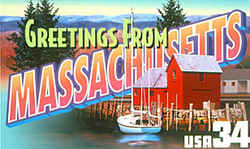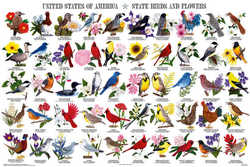
Massachusetts Symbols
Massachusetts State Game Bird
Wild Turkey

(Meleagris Gallopavo)
Adopted on December 23, 1991.
The wild turkey, (Meleagris gallopavo,) which was eaten at the first Thanksgiving, was designated the state game bird on December 23, 1991.
The scientific name was first properly applied by Linnaeus in 1758, (Meleagris gallopavo.) Meleagris in Latin means Guinea Fowl and gallopavo, the Latin "gallus" meaning cock and pavo meaning peafowl. Even in Linnaeus's time there was confusion in the origin of the bird. Guinea Fowl are African in origin and Peafowl, Asian.
Did you know that: The Wild Turkey has been proclaimed the official state game bird in each of the following states:
Alabama | Massachusetts | Oklahoma | South Carolina
Massachusetts State Game Bird: Wild Turkey

The wild turkey is one of the largest birds in North America. An adult male can grow up to 4 feet long from his beak to his tail. Males have a dark, iridescent body. The flight feathers are black with brown stripes and are barred with white. Thw wild turkey has red wattles, a caruncle, and a blackish breast tuft. The wattle comprises the fleshy lobes hanging down from the chin or throat. The caruncle is the wart-like projections of the skin attached to the upper part of the forehead. The legs are spurred and spurs can grow as long as 3.175 centimeters. The leg scales are pink, pinkish gray, or silver gray. The head of the adult gobbler (male) is red, blue, or white depending on the bird's emotional status and on the season. Female turkeys are smaller and duller than males, and lack a breast tuft. Females also have a grayish head and the back of the neck is feathered.
Characteristics of the Wild Turkey
Food Habits
Preferred habitats include mature forests, open woodlands, and farm areas. During the non-breeding season, the birds forage in flocks on the ground for acorns, seeds, some leaves, salamanders, worms, snails, and insects. Food items are swallowed whole and ground up in the bird's gizzard.
Reproduction
In the Northeast, gobbling usually starts around mid-March, peaking in late April or early May. Males perform courtship displays by strutting and gobbling. During the spring, males will fan out their tails, strut and gobble in an attempt to attract and hold a harem of females. The call of the male Wild Turkey (also called a gobble) can be heard a 1.61 kilometers away. The Wild Turkey is polygamous, therefore one male will attempt to mate with several females. Eggs are laid two to three weeks after copulation. The hen usually nests on the ground in a depression, and the nest is usually surrounded by dense brush, vines, tangles, deep grass, or fallen tree tops. The nest contains 8-15 eggs. The incubation period is 28 days.
In Massachusetts broods usually appear about the first week of June. The young poults are active as soon as they hatch, and about 25 to 50 percent will survive until the fall. Predators such as foxes and goshawks may take a few young turkeys, and cold spring rains are also a hazard since the poorly-feathered young birds are easily chilled.
Behavior
By day the turkey can be seen grazing in fields and woodlands. At night turkeys roosts in trees. The Wild Turkey is a very wary bird with keen eyesight and hearing. In spite of its large size and rather awkward appearance, the wild turkey is a powerful flier, reaching speeds of up to 55 mph over short distances. Turkeys will most often fly hard and fast up through the treetops, then set their wings and glide back to the ground. In the fall, the turkeys flock with several males accompanying several females. There is no calling (unless the flock gets broken up) and there are no displays similar to those seen in the spring. The main objective is to gather enough fat reserves for the winter.
Habitat
Habitats preferred by wild turkeys include mixed coniferous and deciduous forests. Agricultural fields, orchards, and seasonal marshes are also locations favored by M. gallopavo.
Massachusetts General Laws
The law designating the wild turkey as the official Massachusetts state game bird is Chapter 2: Section 36. (Game bird of commonwealth) of The General Laws of Massachusetts, PART I (ADMINISTRATION OF THE GOVERNMENT) TITLE I (JURISDICTION AND EMBLEMS OF THE COMMONWEALTH, THE GENERAL COURT, STATUTES AND PUBLIC DOCUMENTS) CHAPTER 2 (ARMS, GREAT SEAL AND OTHER EMBLEMS OF THE COMMONWEALTH) Section 36.
PART I. ADMINISTRATION OF THE GOVERNMENT.
TITLE I. JURISDICTION AND EMBLEMS OF THE COMMONWEALTH, THE GENERAL COURT, STATUTES AND PUBLIC DOCUMENTS.
CHAPTER 2. ARMS, GREAT SEAL AND OTHER EMBLEMS OF THE COMMONWEALTH.
Chapter 2: Section 36 Game bird of commonwealth
Section 36. The wild turkey (Meleagris Gallopavo) shall be the game bird and game bird emblem of the commonwealth.
Taxonomic Hierarchy: Wild Turkey
Kingdom: Animalia (animal)
Phylum: Chordata (chordates)
Class: Aves - Aves (birds)
Order: Galliformes (fowls)
Family: Phasianidae - Partridges, Turkeys, Grouse, Pheasants, Quail, cailles, faisans
Subfamily: Meleagridinae - Turkeys
Genus: Meleagris Linnaeus, 1758 - Turkeys
Species: Meleagris gallopavo Linnaeus, 1758 - Guajolote norteno, Wild Turkey, dindon sauvage
Taxonomic Serial No.: 176135







